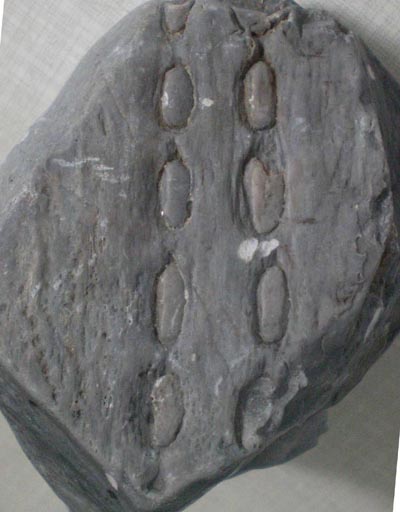An uncommon type of Syringodendron
The ancient relatives of the extant clubmosses, among them the big
Sigillaria
trees, were part of the coal swamp vegetation [1]. There were
several species distinguished by the arrangement and shape of their
leaf-scars on the stem surface. The stems often
seem to somehow have
lost an outer layer with the leaf scars before
fossilisation. The partially decorticated stems show another aspect,
called Syringodendron
(see image). It can be expected that there are at least as many
different Syringodendron
patterns as there are Sigillaria
species.
The elements of the Syringodendron
pattern (also called scars here for short) are doubtless related to the
veins running from the inner stem to the leaves but their large size
suggests an extension by other tissue. Usually they come in pairs, and
the pairs come in files.

Photograph: Syringodendron
pattern on the surface of a sample of soft laminated gray chert with
compressed plant debris, angular fragment of a chert layer, with glossy
faces; Nobitz gravel pit (NW-Saxony, Germany), probably Upper
Carboniferous or
Lower Permian. Height of the picture 6.5cm.
The present specimen is special: It does not prompt the idea of a file
of pairs but of a pair of chains, which is brought about by three
features which, in this combination, are apparently not observed with
other forms of Syringodendron:
(1) The lateral spacing of the paired scars is wider than the
width of the scars.
(2) The gaps in the file are much smaller than the length of
the scars.
(3) The scars are almond-shaped.
Several Syringodendron specimens
from the Carboniferous of Villablino, Spain, are
similar to the present one but differ in (1) or (2) [2].
The depth of the relief with the scars on the surface of this
sample is up to 1mm. A surface layer of about the same thickness has an
inconspicuous texture along the stem direction. No texture or structure
is seen on the scars. What is most peculiar, there is neither a trace
of a vein extending into depth below the scars nor of a tree trunk.
The
bulk of this sample consists of a laminated sediment with compressed
plant debris so closely spaced that it may be called fossil peat. It
is a rather soft chert variety, possibly with
some percentage of clay minerals, as it is
found in the
gravel of the Nobitz gravel pit.
The low hardness shows
as white spots due to impact.
Finally it can be said that this sample poses some questions:
- Which Sigillaria
species is compatible with this Syringodendron
pattern ?
- Why is the pattern preserved as a relief while everything
else is squeezed flat ?
- What became of the rest of the stem ?
As
one thinkable option, the stem could have been on top of the
sample surface so that the pattern would be only a replica. However,
the deep
grooves around the scars seem to contradict this. Anyway, the sample
remains enigmatic.
Sample: found by Sieglinde
Weiss at Nobitz in 2009, kept in
own collection under No/10.
H.-J. Weiss
2011
[1] H. Steur:
www.xs4all.nl/~steurh/
[2] http://labolsaparda.blogspot.com/
|

|
 10 10 |

 10
10

 10
10